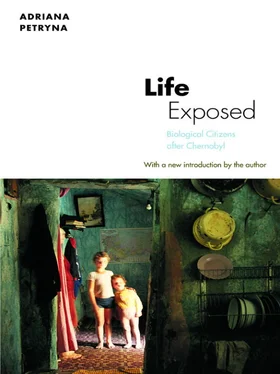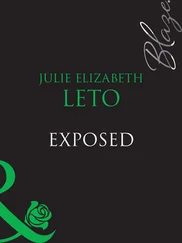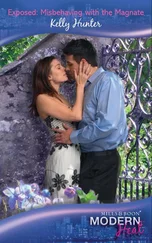What is the relationship between individual suffering caused by the Chernobyl accident and the technical measures and scales of expertise used to assess radiation-related biological injury? In this chapter, I trace the work of international scientific networks in patterning initial Soviet remediation strategies and public health responses. I explore key aspects of the initial Soviet management of the Chernobyl disaster and show how definitions of radiation-related injury were informed by an array of international scientific and political interests, and elaborated through a particular set of technical strategies. Accounts of injury were limited to biomedical measures derived from a group of acute accident victims in the first few weeks following the disaster. Such activities limited Soviet government liability for the many populations that were not screened or that were possibly made vulnerable to radiation-related injuries in the future.
Such interventions illustrate the ways experiences of illness are engendered and understood within the technical and political domains where they come to be addressed. With the collapse of authoritarian power, they clearly opened the way to a new form of politics based on the (unaccounted-for) scope of biological injury in the future. Adding further perspective on how this politics could take shape, we must also recognize that among radiation research scientists working in U.S. laboratories, there is considerable disagreement as to suitable parameters for interpreting radiation-induced biological risk in human populations. There is also disagreement among them as to how various experimental data may be unified in terms of a systematic theoretical approach (Chatterjee and Holley 1994:222). This lack of consensus at the basic science level deals a blow to the confidence that inspires expert claims to knowledge in the field. Ambiguities related to the interpretation of radiation-related physical damage subjected post-Chernobyl state interventions and medical surveillance to a variety of competing scientific and political interests. Scientists and government leaders garnered resources on the basis of those ambiguities to make claims for their own legitimacy and to push their scientific research and political agendas forward.
Scientist and Soviet political observer Zhores Medvedev has authoritatively detailed emergency measures taken after the Chernobyl accident, with particular emphasis on the first ten days, when officials were acting under the protection of a news blackout (1990:41). [2] During this information blackout “no technical details were given” of the emergency measures undertaken to control the accident situation. Medvedev defines emergency measures in terms of “the initial response to the accident in the first ten days when officials were acting under the protection of the news blackout. They also include the attempts to decontaminate the area, to construct a ‘sarcophagus’ around the reactor to isolate it from the environment, to establish hydrological isolation of the plant site and to set up effective dosimetric control of food” (1990:41).
In the following paragraphs, I want to convey something of the technical responses that ensued to assess a radioactive Chernobyl plume. The work of estimating its fallout was based upon approximations and semiempirical models. In retrospectively surveying this technical work and its inherent problems, we arrive at a finer map of a domain of anthropological inquiry. I approach this surveying work as a multilocale investigation of transnational, state, and local forces and actions that to some extent framed what we currently know and do not know about the human toll of the Chernobyl aftermath.
I turn first to the question of the size of the plume and how best to image it. Tom Sullivan is the former director of the Atmospheric Release Advisory Capability (ARAC) at Lawrence Livermore National Laboratory (LLNL) in Livermore, California. Sullivan’s team worked with the U.S. Nuclear Regulatory Commission to assess the severity of the disaster. When I interviewed his research team in 1997, members were still refining estimates of the height of the Chernobyl explosion’s plume.
Prior to Chernobyl, the ARAC researchers compiled meteorological data, satellite photos, wind patterns, and atmospheric activity data to model sizes and movements of nuclear plumes associated with above-ground American and Chinese nuclear weapons tests and the Three Mile Island accident. They developed computer codes calculating concentrations of contaminated material at a certain location; they tracked contaminated plumes for a distance and, based on certain meteorological conditions, estimated concentrations of radioactive contamination at any point in time along a trajectory.
The historical context of the Cold War prevented ARAC from modeling the movements of the Chernobyl plume in real time. Limitations on the sharing of sensitive data between Western and Soviet regimes made it difficult for U.S. scientists to locate the plume in Soviet air space. “The problem was there were no weather charts for that part of the world.” [3] In the absence of Soviet data on the plume’s source, Sullivan and his team inferred its origin on the basis of weather charts provided by the United States Air Force.
Additionally, the source of the plume was difficult to locate, since maps of Soviet nuclear installations were kept secret.
Sullivan’s team relied on meteorological data showing the arrival of the plume in Sweden and used Swedish measurements to “invert the mathematics of the calculation. Given the concentration in Sweden… we estimated on the order of 2 megacuries of iodine and cesium were being released.” Their mathematically generated trajectory showed the source of the plume to be “at or near the Baltics.” [4] This mapping occurred between April 28 and 29. Sullivan told me that separate teams affiliated with the Nuclear Regulatory Commission and the International Atomic Energy Agency were working on the same thing and cross-checking their data.
After intense international pressure, the Soviets admitted that a catastrophic meltdown had occurred at Chernobyl. ARAC’s computers were coded to map plumes within a limited spatial range. Once the team had refined their trajectory and located the source of the Chernobyl plume in northern Ukraine, Sullivan told me, his computer programs “weren’t ready” for what they had found:
We typically operated within a two-hundred-by-two-hundred-kilometer area. This area had been sufficient to model prior releases such as the one at Three Mile Island and American and Chinese nuclear weapons tests. Our first calculations were on a two-hundred-kilometer-square grid. We did the imaging near the Chernobyl plant, but the grid was so saturated, I mean, you couldn’t even make sense of it because every place had these enormously high values— they filled the whole grid, in every direction …. Our codes were not prepared for an event of this magnitude.
Sullivan’s team found something “far worse” than a meltdown. A runaway chain reaction of uranium-235 contributed to a powerful explosion, capable of rupturing any modern form of structural containment. “We knew there had been a core meltdown after Swedish scientists sampled the plume. They found mono-elemental particles of pure ruthenium, indicating that a meltdown of the reactor core had occurred.” [5] Ruthenium’s melting point is 2,250 degrees Celsius. The presence of ruthenium in the plume’s trace meant that a meltdown of the reactor core had taken place. Zirconium, used for cladding nuclear fuel, melts at 1,852 degrees.
Sullivan’s team conducted real-time atmospheric modeling of hazardous airborne materials. Computer codes were designed to do this modeling within a limited space. Assessment of the situation required a technical upgrade, which the Nuclear Regulatory Commission was ready to support. The team had initially tried to adjust the system to account for a larger territory “to get us into Scandinavia and Western Europe.” In the second week following the explosion, there were reports that the radioactive plume had reached Japan. The team decided that they needed a hemispheric model. [6] According to Sullivan, “We suddenly realized that we needed an enormous amount of data. The quantity of data we were not at all set up to receive in terms of spatial size nor in terms of extent in time. For example, in a usual model calculation we were limited to five upper air stations and where there are fifteen or thirty or something like that surface stations. And now we are dealing with hundreds of upper air stations and thousands of surface stations.”
According to Sullivan, “that was another step in changing the whole system and implementing new capabilities.” New technologies allowed them to “drive [their] transport models and model the entire plume as it moved around the Northern Hemisphere.” [7] After Chernobyl, Sullivan’s team started to model such things as volcanic ash fires and the Kuwaiti oil fires in real time.
Читать дальше












